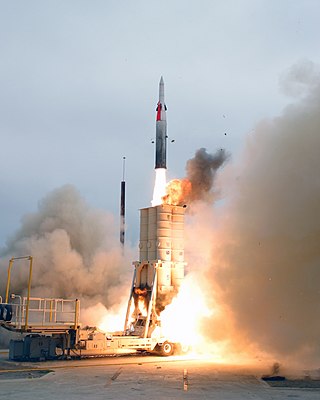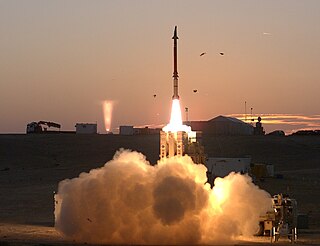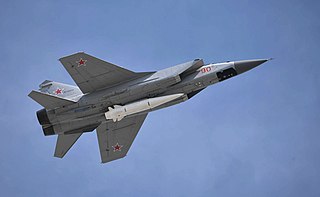
A cruise missile is an unmanned self-propelled guided vehicle that sustains flight through aerodynamic lift for most of its flight path and whose primary mission is to place an ordnance or special payload on a target. Cruise missiles are designed to deliver a large warhead over long distances with high precision. Modern cruise missiles are capable of traveling at high subsonic, supersonic, or hypersonic speeds, are self-navigating, and are able to fly on a non-ballistic, extremely low-altitude trajectory.

The MIM-104 Patriot is a surface-to-air missile (SAM) system, the primary such system used by the United States Army and several allied states. It is manufactured by the U.S. defense contractor Raytheon and derives its name from the radar component of the weapon system. The AN/MPQ-53 at the heart of the system is known as the "Phased Array Tracking Radar to Intercept on Target," which is a backronym for "Patriot". In 1984, the Patriot system began to replace the Nike Hercules system as the U.S. Army's primary high to medium air defense (HIMAD) system and the MIM-23 Hawk system as the U.S. Army's medium tactical air defense system. In addition to these roles, Patriot has been given a function in the U.S. Army's anti-ballistic missile (ABM) system. As of 2016, the system is expected to stay fielded until at least 2040.

The Arrow or Hetz is a family of anti-ballistic missiles designed to fulfill an Israeli requirement for a missile defense system that would be more effective against ballistic missiles than the MIM-104 Patriot surface-to-air missile. Jointly funded and produced by Israel and the United States, development of the system began in 1986 and has continued since, drawing some contested criticism. Undertaken by the MALAM division of the Israel Aerospace Industries (IAI) and Boeing, it is overseen by the Israeli Ministry of Defense's "Homa" administration and the U.S. Missile Defense Agency. It forms the long-range layer of Israel's multi-tiered missile defence system, along with David's Sling and Iron Dome and Iron Beam.

National missile defense (NMD) refers to the nationwide antimissile program the United States has had in development since the 1990s. After the renaming in 2002, the term now refers to the entire program, not just the ground-based interceptors and associated facilities.
Rafael Advanced Defense Systems Ltd. is an Israeli defense technology company. It was founded as Israel's National R&D Defense Laboratory for the development of weapons and military technology within the Israeli Ministry of Defense; in 2002 it was incorporated as a limited company.

The Missile Defense Agency (MDA) is a component of the United States government's Department of Defense responsible for developing a comprehensive defense against ballistic missiles. It had its origins in the Strategic Defense Initiative (SDI) which was established in 1983 by Ronald Reagan and which was headed by Lt. General James Alan Abrahamson. Under the Strategic Defense Initiative's Innovative Sciences and Technology Office headed by physicist and engineer Dr. James Ionson, the investment was predominantly made in basic research at national laboratories, universities, and in industry. These programs have continued to be key sources of funding for top research scientists in the fields of high-energy physics, advanced materials, nuclear research, supercomputing/computation, and many other critical science and engineering disciplines—funding which indirectly supports other research work by top scientists, and which was most politically viable to fund from appropriations for national defense. It was renamed the Ballistic Missile Defense Organization in 1993, and then renamed the Missile Defense Agency in 2002. The current director is U.S. Navy Vice Admiral Jon A. Hill.

Spike is an Israeli fire-and-forget anti-tank guided missile and anti-personnel missile with a tandem-charge high-explosive anti-tank (HEAT) warhead. As of 2024, it is in its sixth generation. It was developed and designed by the Israeli company Rafael Advanced Defense Systems. It is available in man-portable, vehicle-launched, helicopter-launched and maritime variants.

Hypersonic flight is flight through the atmosphere below altitudes of about 90 km at speeds greater than Mach 5, a speed where dissociation of air begins to become significant and high heat loads exist. Speeds over Mach 25 have been achieved below the thermosphere as of 2020.
The Indian Ballistic Missile Defence Programme is an initiative to develop and deploy a multi-layered ballistic missile defence system to protect India from ballistic missile attacks. It was launched in 2000 after Kargil War by the Atal Bihari Vajpayee government. Testing was carried out and continuing as of 2006, and the system was expected to be operational four years from then according to the head of the country's missiles development programme, Vijay Kumar Saraswat.

Iron Dome is an Israeli mobile all-weather air defense system, developed by Rafael Advanced Defense Systems and Israel Aerospace Industries. The system is designed to intercept and destroy short-range rockets and artillery shells fired from distances of 4 to 70 kilometres (2–43 mi) away and whose trajectory would take them to an Israeli populated area. From 2011 to 2021, the United States contributed a total of US$1.6 billion to the Iron Dome defense system, with another US$1 billion approved by the US Congress in 2022.

David's Sling, also formerly known as Magic Wand, is an Israel Defense Forces military system jointly developed by the Israeli defense contractor Rafael Advanced Defense Systems and the American defense contractor Raytheon, that became operational in 2017. It is designed to intercept enemy planes, drones, tactical ballistic missiles, medium to long-range rockets and cruise missiles, fired at ranges from 40 to 300 km. David's Sling is intended to replace the MIM-23 Hawk and MIM-104 Patriot in the Israeli arsenal.

Missile defense systems are a type of missile defense intended to shield a country against incoming missiles, such as intercontinental ballistic missiles (ICBMs) or other ballistic missiles. The United States, Russia, India, France, Israel, Italy, United Kingdom, China and Iran have all developed missile defense systems.

The Arrow 3 or Hetz 3 is an exoatmospheric hypersonic anti-ballistic missile, jointly funded, developed and produced by Israel and the United States. Undertaken by Israel Aerospace Industries (IAI) and Boeing, it is overseen by the Israeli Ministry of Defense's "Homa" administration and the U.S. Missile Defense Agency. It provides exo-atmospheric interception of ballistic missiles, including intercontinental ballistic missiles (ICBMs) carrying nuclear, chemical, biological or conventional warheads. With divert motor capability, its kill vehicle can switch directions dramatically, allowing it to pivot to see approaching satellites. The missile's reported flight range is up to 2,400 km (1,500 mi).
The DF-ZF is a hypersonic glide vehicle (HGV) developed by the People's Republic of China. It is launched by the DF-17 medium-range ballistic missile. The combined weapon system was likely operational by October 2019.

Iron Beam, officially מגן אור, magen or, Shield of Light is a directed-energy weapon air defense system unveiled at the Singapore Airshow on February 11, 2014 by Israeli defense contractor Rafael Advanced Defense Systems. The system is designed to destroy short-range rockets, artillery, and mortar bombs; it has a range of up to 7 km (4.3 mi), complementing the Iron Dome system which was designed to intercept missiles launched from a greater distance. In addition, the system could also intercept unmanned aerial vehicles. Iron Beam will constitute the fifth element of Israel's integrated missile defense system, in addition to Arrow 2, Arrow 3, David's Sling and Iron Dome.

A hypersonic glide vehicle (HGV) is a type of warhead for ballistic missiles that can maneuver and glide at hypersonic speed. It is used in conjunction with ballistic missiles to significantly change their trajectories after launch. The concept of HGVs is similar to MaRVs, but HGVs are separated from their rocket boosters shortly after launch as opposed to MaRVs which can only maneuver just before the impact. Conventional ballistic missiles follow a predictable ballistic trajectory and are vulnerable to interception by the latest anti-ballistic missile (ABM) systems. The in-flight maneuverability of HGVs makes them unpredictable, allowing them to effectively evade air defenses. As of 2022, hypersonic glide vehicles are the subject of an arms race.

The Kh-47M2 Kinzhal is a Russian hypersonic air-launched ballistic missile. It has an estimated range of 460–480 km (290–300 mi) and a reported top speed of Mach 10. It can carry either conventional or nuclear warheads and can be launched by Tu-22M3 bombers, MiG-31K interceptors, or modified Su-34 fighter-bombers. It is the first hypersonic weapon used.

The Multi-Mission Launcher (MML) is an open-systems architecture multi-role missile launching system created by the United States Army's Aviation and Missile Research, Development, and Engineering Center.

A hypersonic weapon is a weapon capable of travelling at hypersonic speed, defined as between 5 and 25 times the speed of sound or about 1 to 5 miles per second.

Fattah-1 is an Iranian hypersonic medium-range ballistic missile developed by the Islamic Revolutionary Guard Corps and unveiled in 2023. It is Iran's first hypersonic ballistic missile. According to Iran, its high maneuverability and speed helps it to evade missile defense systems. Its name, meaning "conqueror" or "bringer of victory", "victor" in Arabic, is in reference to Al-Fattāḥ, was selected by the Supreme Leader of Iran.
















